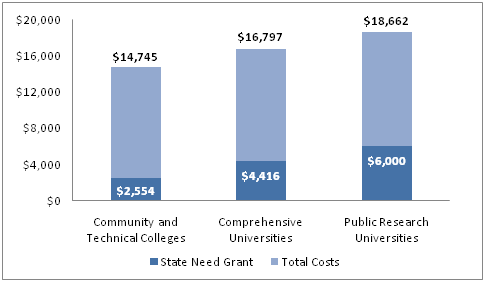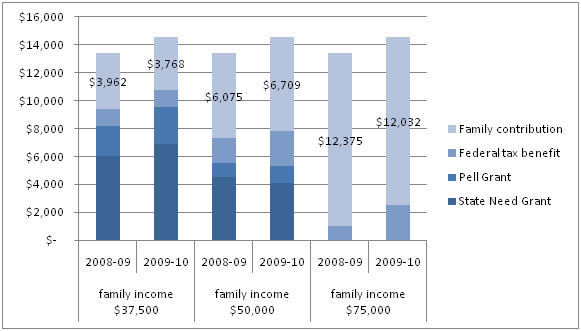 Focusing scarce public resources on students from the lowest-income families is a reasonable policy choice, but the long term disinvestment in higher education by both the state and federal governments has clearly limited college access for low income and middle class students. As the cost of attending college continues to escalate, more and more students and their families – not just those classified as low-income – are truly struggling to afford higher education.
Focusing scarce public resources on students from the lowest-income families is a reasonable policy choice, but the long term disinvestment in higher education by both the state and federal governments has clearly limited college access for low income and middle class students. As the cost of attending college continues to escalate, more and more students and their families – not just those classified as low-income – are truly struggling to afford higher education.
State Need-Based Grants
Washington provides some grant aid to students from lower income families through State Need Grants (SNG). Students from families with incomes below 50% of the state median family income – or $37,500 for a family of four in 2007-08 – are eligible for the maximum grant amount. Students in families up to 70% of the state median income ($52,500 for a family of four) are eligible for partial grants.
The maximum SNG award for 2008-09 covered 94% of community and technical college tuition and fees and 90% of four-year college tuition and fees. However, tuition makes up only a small portion of total expenses. The maximum annual award of $6,000 for students in public four-year colleges covered only 32% of total costs, and the maximum award for community college students of $2,554 made up only 17% of estimated total costs for the 2008-09 academic year.
Estimated Costs of Attending Washington Institutions of Higher Education vs. Maximum State Need Grant
students living away from home, 2008-09

Source: Higher Education Coordinating Board
2008-09 Sample Budget for Washington Students Living Away from Home

Source: Higher Education Coordinating Board: College Access and Affordability Presentation to House Higher Education Committee (2/6/2009)
Federal Aid
The other main grant options for students in public colleges come from the federal government, and are also limited to those from lower-income families. The Pell Grant represents the federal government’s main commitment to providing college accessibility. In order to be eligible for a Pell Grant, students must have an Estimated Family Contribution (EFC) of less than $4,617 in the 2009-10 academic year, up from $4,017 in 2008-09.
To put this into perspective, in the 2007-08 academic year, roughly 90% of all Pell Grant awards went to students with family incomes of less than $40,000 per year. Furthermore, Pell Grants are distributed on a sliding scale. In 2007-08, 85% of grants over $2,100 (roughly half of the maximum award that year) went to students with family incomes of less than $30,000 per year.
The 2009 American Recovery and Reinvestment Act (ARRA) raises the maximum Pell Grant award, from $4,371 to $5,350, in an attempt to make up for the fact that over the past four decades the grant has failed to keep pace with increases in tuition. In the 1970’s a maximum Pell Grant award was enough to cover 77% of the total costs of attending the average four-year public school, and almost 100% cost at the average two-year public school. By 2008-09, the maximum award could only cover 35% of average costs at four-year public schools, and 68% of costs at two-year institutions.
The federal government’s primary assistance to middle class students has been in the form of tax breaks and loans. The ARRA replaced the Hope Tax Credit with the American Opportunity Tax Credit and made it available to more families. Now students from families with adjusted gross incomes (AGI) up to $80,000 (or $160,000 for joint filers) can take a tax credit for the first $2,000 of tuition and school-related expenses, and 25% of the next $2,000 of tuition and expenses, for a total maximum credit of $2,500 per year. The credit is also now available for four rather than two years per student.
Estimated Student Budget at University of Washington for a Student Living with Parents
2008-09, 2009-10

Source: University of Washington, Office of Admissions and Student Office of Financial Aid
While a welcome change for some families, these tax savings account for only a fraction of the cost of higher education. During the 2007-08 academic year, 76% of non-tax federal aid to college students in Washington was in the form of loans. Improvements to the Pell Grant help the lowest-income students, but do very little to address the student debt problems that middle- and lower-middle-income students are facing as colleges move towards high-tuition/high-aid models of financing.
2009-11 State Budget – Restricting Access to Higher Education
Paradoxically, Washington state legislators are using the federal government’s reprioritization of higher education as an excuse to further disinvest in higher education. The argument being put forth by some legislators and top college administrators is that these expanded federal programs will offset the massive tuition hikes they have scheduled for the next two years. For example, at the UW, administrators justified their request for the maximum hike of 30% over two years by forecasting that students from households with combined incomes of less than $96,000 per year will feel no net effect due to increases in the Pell Grant and HOPE credit.
However, assuming that increased financial aid will offset the effect on low-income students of raising tuition ignores the well-documented effects of sticker shock. Further, the Legislature reduced State Need Grants for students from families with incomes between 50% and 65% of state median family income.
A comparison of estimated public financial aid available to students with projected student budgets at the University of Washington for the 2008-09 and 2009-10 school years shows that those with incomes about half way between the poverty level and the median come out the worst. They neither qualify for maximum need-based grants, nor benefit from the expansion of federal tax credits to a broader section of the middle class. Students from families with incomes of $50,000 will likely have to pay more in the coming year to attend the University of Washington than last year, whether living with their parents or away from home, while those with incomes somewhat higher or lower will pay a little less.
Estimated Family Contribution by Income for Family of Four at University of Washington
after state need grant, pell grant and federal tax benefits – 2008-09 and 2009-10

Based on typical awards from the State Need Grant and Pell grant, and federal tax benefits for a family of four for academic years 2008-09 and 2009-10. Authors’ calculations from Higher Education Coordinating Board, U.S. Department of Education, IRS, and University of Washington data.
The improvements to the federal aid programs are intended to address a problem that already exists. To raise tuition in proportion to these improvements and claim that there will be “no net effect” ignores the fact that students are already hurting and may be counting on these federal benefits as a source of relief.
Student access has also been restricted more directly. The legislature reduced budgeted annual enrollment at the state’s public four-year colleges and universities by 4,400 students for 2009 through 2011. Meanwhile, the number of seniors enrolled in Washington public high schools has increased in each of the past four years, meaning more young people will be competing for fewer positions in the state’s higher education system.
To fix our schools, we must fix our tax system
In 2006, Washington Learns made bold recommendations to create a world class education system in Washington State. However, real progress towards those goals, from preschool through graduate education, has been stymied by a lack of public investment.
Over the past two decades and more, Washington State has increasingly fallen behind the level of funding needed to boost quality and maintain access to higher education. The current severe recession and consequent state budget crisis compound the problem, but the financing problem will remain even when the economy recovers.
Washington’s regressive and outmoded tax structure remains one of the primary obstacles to education reform. As long as our tax base shrinks relative to the whole economy and relies too heavily on contributions from low- and middle-income state residents – while taxing the wealthy too lightly – we will not be able to raise sufficient public revenues to build the education system state residents want and deserve.
Note: This is the fifth in a five-part series based on EOI’s latest report: Losing By Degrees. View part 1 here, part 2 here, part 3 here, part 4 here.
More To Read
May 19, 2025
A year of reflections, a path forward
Read EOI Executive Director's 2025 Changemaker Dinner speech
March 24, 2025
Remembering former Washington State House Speaker Frank Chopp
Rep. Chopp was Washington state’s longest-serving Speaker of the House
February 11, 2025
The rising cost of health care is unsustainable and out of control
We have solutions that put people over profits
